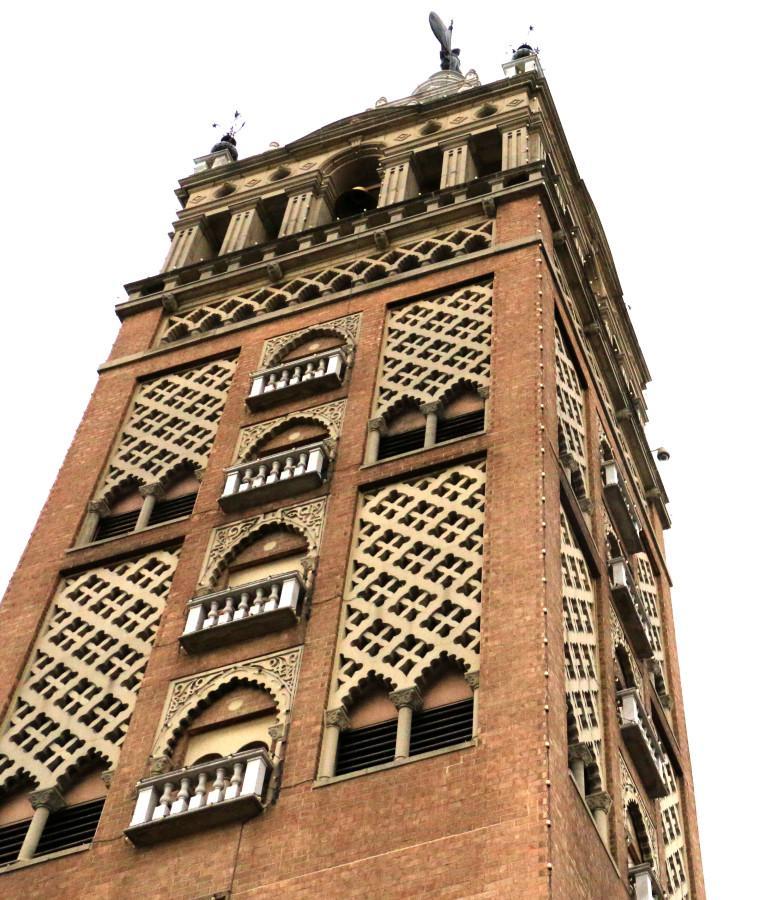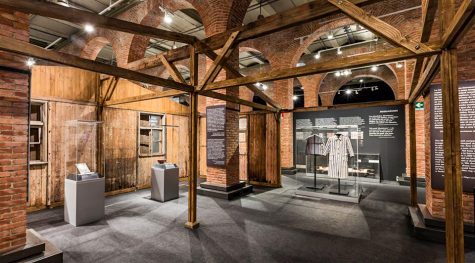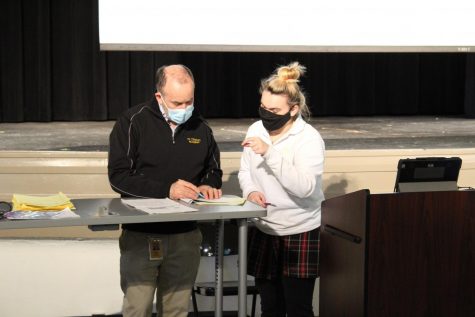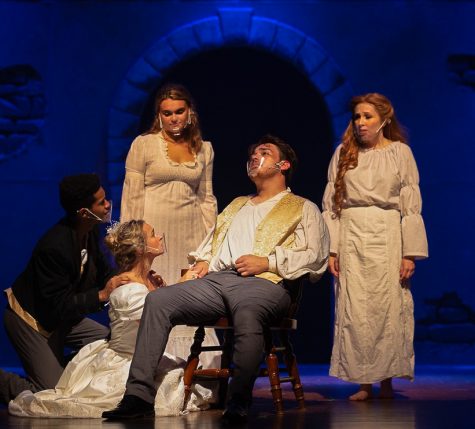A shopping center of debate
Since assuming ownership of the Country Club Plaza, real estate company Highwoods Properties has stimulated both developments and controversies.
December 30, 2014
story and photos by Emma Willibey
Waters ravaged the shops, crippling tenants with fear. The 55-year-old district teetered toward destruction, relying on the mercy of a raging creek. And, Americans across the country would attend the 1977 Plaza Art Fair in 10 days.
Yet, the day after the 1977 Brush Creek flood hit Kansas City’s Country Club Plaza, a movement began to reopen shops and clean the area. According to the Plaza’s website, fewer than six shops closed of the “many” damaged, and the Art Fair flourished on its scheduled date.
“The main thing that I appreciate from that time period is how quickly the city helped,” Gayle Terry, marketing director of Plaza owner Highwoods Properties, said.
The Plaza originated in 1907, when Nichols bought his first chunk of land for the shopping district, according to the Plaza’s website. According to Terry, Nichols’ aesthetic vision transformed the Plaza from a swamp into “a critical place” by the 1930s. When the Plaza transferred ownership from the J.C. Nichols Company to Highwoods in 1997, people expected Highwoods to preserve their landmark, Terry said.
“I absolutely think this place matters to people,” Terry said.
According to Terry, one of Highwoods’ priorities is maintaining the Plaza’s spectrum of stores. While the Plaza initially drew high-end Kansas Citians, a geographic shift diversified the Plaza’s shoppers, Terry said.
“[The Plaza] started off with [wealthy] people arriving by automobile,” Terry said. “Then, the city started to move more south, more around the Plaza, and [the Plaza] started to be more welcoming to other groups.”
Under Highwoods’ direction, the Plaza has introduced shops with differing price ranges, from Tiffany & Co. to H&M. According to Terry, Highwoods has also catered to all shoppers with a balance of local and chain shops.
“Right now about a third of our restaurants and stores are locally owned,” Terry said. “[People] want to run into [local clothier] Baldwin, but they also run into Gap.”
Despite Highwoods’ renovations, notable stores have left the Plaza since the company assumed ownership. Last July, the department store Halls’ Plaza location closed after almost 50 years, and the store’s Crown Center location expanded.
According to Halls’ vice president creative services, Carnie Kline, the store moved due to the financial sensibility of combining two nearby stores. An article in Halls’ fall 2013 magazine also cited downtown development as an incentive for the revamped Halls on Grand.
“The re-growth of a vibrant downtown Kansas City is demonstrated on an almost daily basis,” the article states, citing institutions like the Kauffman Center for the Performing Arts and the Sprint Center. “Halls intends to be an important part of that growth with its new store.”
While not participating in the downtown revival, Highwoods has developed the Plaza. In 2000, Highwoods created Valencia Place along 47th Street, bringing shops such as seafood restaurant McCormick & Schmick’s and clothing store Banana Republic. In 2002, the Granada Shops filled the opposite side of 47th Street with retailers like fitness clothier Athleta and outdoor store Moosejaw.
“The entire stretch of 47th Street didn’t use to have retail,” Terry said.
In addition to the varied retail, the Plaza’s Spanish architecture distinguishes the area, according to the Country Club Plaza’s website. The website states the styles of Valencia Place and the Granada Shops are “harmonious” with those of original buildings.
However, Highwoods caused controversy in 2010 by proposing an eight-story glass building for the Polsinelli law firm on 47th Street and Broadway Boulevard. The construction would require destroying the 1920s “balcony building.”
“[The proposed building had a] boxy, plain style which was just not in keeping with the historic details of the Spanish architecture,” Jan Bentley, inactive member of Plaza advocacy group Friends of the Plaza, said.
Bentley discovered the proposal in a Kansas City Star article published Aug. 20, 2010. The following morning, Bentley and around 10 colleagues, present and former members of Historic Kansas City (HKC), met at breakfast diner First Watch to discuss Highwoods’ proposal. According to a few architectural historians in the group (soon named “Save Our Plaza”), the proposal violated the 1989 Plaza Plan.
“[According to the Plaza Plan, building heights] have to [rise] in the shape of a bowl,” Bentley said. “[On the inside would be] low, two-story buildings, and then buildings have to get taller on the edges.”
According to HKC executive director Amanda Crawley, Highwoods’ proposal was effectively nine stories taller than the Plaza Plan allowed. While advertised as eight stories, the building possessed a height-per-story larger than that of nearby buildings, Crawley said. Thus, the building was comparable to a 12-story structure, and the Plaza Plan reserved most of the site for one- to three-story structures.
Save Our Plaza was not only concerned with this height violation, but with Highwoods’ attempt to change the Plaza’s land use (or “rezone”) from residential to office. Under current land use, Highwoods could only use the proposed site for housing, not for office space.
“The Plaza Plan … said they did not recommend that site for rezoning,” Crawley said.
Condominium residents of the Plaza, whose views would have been blocked by the building, also disliked Highwoods’ plan. Three such residents, along with two Plaza advocates rallying for the building’s rejection on Facebook, joined Save Our Plaza to stop Highwoods’ proposal. Campaigning began in September.
“Our key people had to meet with the key people in the City Planning Department and at City Hall to convince them [Highwoods’ proposal] was wrong,” Bentley said.
By this time, negative public reactions had led Highwoods to modify its proposal so construction spared the balcony building. However, Highwoods did not alter the proposed building’s height or the proposed rezoning.
So, Save Our Plaza held public information sessions, protests and neighborhood-meeting presentations to oppose Highwoods’ building. This campaigning culminated in a City Council hearing Feb. 15, 2011, in which the City Plan Commission (CPC) rejected Highwoods’ proposal 3-2, according to Ink magazine.
“We had so many people on our side who were mad about [the proposal],” Bentley said.
According to Ink, Kansas City Councilman Bill Skaggs dismissed the CPC’s vote, claiming the full Kansas City Council should decide the issue. In April 2011, the Kansas City Council voted 8-3 in favor of Highwoods’ proposal, but mayor Mark Funkhouser vetoed the decision the following day. In May, the City Council re-voted, again favoring the proposal.
After the City Council’s re-vote, Save Our Plaza started a month-long petition to place the issue on the November ballot. This required 7,144 signatures, and Save Our Plaza obtained over 17,000. While Crawley said only around 11,000 signatures were considered acceptable, as the county clerk eliminated names that did not match names on voting records, Save Our Plaza had still exceeded its goal.
“[The petition] put the fear in … Polsinelli,” Bentley said. “[Having the issue on the November ballot] would drag [the case] out four to six months.”
According to Bentley, the issue’s placement on the ballot would conflict with Polsinelli’s timeline for moving its headquarters. So, Polsinelli parted with Highwoods, shifting its offices to the West Plaza’s Plaza Vista building. In August 2011, Highwoods renounced its building proposal.
“[The Plaza Vista building’s height is] okay, because it’s on the edge of the bowl, and it does not violate the Plaza Plan,” Bentley said.
[nggallery id = 940]
Terry said the proposal was a misstep that was resolved according to Kansas Citians’ wishes. However, Terry said Highwoods has otherwise upheld the Plaza’s architecture, performing traditional maintenance and developing the non-obtrusive Valencia, Granada and Seville parking lots.
“A 92-year-old property just takes so much investment to keep it looking beautiful,” Terry said. “We’ve restored all the towers. The little things like that, no one would ever notice. [But], it sends a signal that you’re being taken care of.”
However, the Plaza’s lack of protection against unsuited developments remains an issue. According to Crawley, the City Planning Department has formed a planning group that meets every two weeks to assess “what could be done in terms of a long-term protection strategy over the Plaza.”
The group includes property owners, HKC board members, Glenn Stephenson (Highwoods’ vice president for Kansas City) and neighborhood stakeholders and members of Friends of the Plaza, an offshoot of Save Our Plaza. While Save Our Plaza accomplished its purpose when Highwoods withdrew its proposal, Friends of the Plaza continues to support advancements that respect the Plaza Plan.
“I think controversy over the Polsinelli building … did create a certain amount of public awareness over the need for some more structure over the Plaza,” Crawley said.
Ultimately, Terry said public concern for the Plaza is inevitable. According to Terry, Highwoods has retained the shopping district’s spirit.
“We are caretakers of one of the city’s crown jewels,” Terry said.









